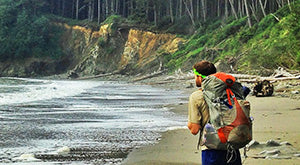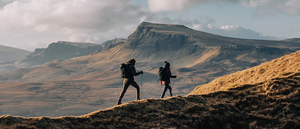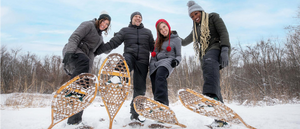A Beginner's Guide to Hiking

With greater awareness about nature, hiking is gaining popularity as a recreational activity. But it can be difficult to begin hiking. You will have plenty of questions about where to begin, how to prepare for your hike etc.? We give you some tips so that you can successfully plan your next hiking trip. Before you start, check out our Experiences section of the Skuxs site. We have worked with Alltrails to make it easy for you to find the perfect hike for you next adventure, no matter where it is. Without further ado, let’s get started:

1. Selecting the Right Trail.
You must be careful not to pick a long or difficult trail in the beginning. Choose a trail within 5 miles (ca. 8 km), which involves the least climbing. The amount of exertion required to cover the distance will differ according to the terrain. Hiking on flat terrain will be very different from hiking on an ascending slope.
Alltrails does an outstanding job of accurately rating hikes based on incline, time to complete, length and overall difficulty. Depending on if you are located in the Canadian Rockies, PNW, Eastern Canada, California or South West United States; the Skuxs
Experiences section makes it easy to find your ideal trail. Using this tool, you will find be able to find plenty of user experiences and trail photos, which will come in handy for your journey. Go through the trail guide. It will contain information about the turns and the time required to complete the trail. Setting out with a fair idea about the trail will give you confidence.
Once you have decided on a trail, do research on the wildlife likely to be found along the trail. You do not want to unexpectedly run into wild animals during your trail. Pick a safe trail during your first hike.

2. Find a Companion.
You can go for a solo hike, but it is always better to have company if you are a beginner. If a friend or family member are not interested in joining you, you can sign up for local hiking groups found on the internet. Sites such as meetup.com and facebook.com are great places to start your search!

3. Finding a Map.
Navigation is very important to prevent you from deviating from the trail which can result in injury or getting lost. Most experienced hikers will use a combination of a compass, map and GPS.
Once again, Alltrails allows you to download the trail map on your mobile device and use solely your phones GPS to track your trail progress.
If you are looking for a dedicated compass, Silva Ranger S Compass and Silva Expedition Compass are some great low cost options.
If a dedicate GPS is more of your thing, the Garmin Fenix 6S offers you a luxurious, yet reliable experience.
4. Dressing up for the Hike.
What you wear for your hike will depend on the climatic conditions. In cold climates, you may want to wear layers of fully covered clothes. In hot climates, shorts and a short-sleeved shirt will be sufficient. Don't wear heavy clothes like jeans or jackets. They become weighty when soaked in moisture. Wear comfortable clothes which allow you to move easily.
Brands such as Outdoor Research, The North Face, Black Diamond and Patagonia make clothes designed for the trail.
Wearing a good pair of hiking shoes is inevitable. They will keep your feet safe. Don't wear your old pair. They may give you blisters or worse give way midway through the hike. If you are buying a new pair, make sure to accustom your feet to your new shoes. Strong shoes must be combined with superior quality woolen or synthetic socks for proper comfort. Check out our recent post regarding hiking boots to wear for the trail.
Carry sunglasses and a hat for sun protection. Be prepared for changes in temperatures. Dressing up in layers will allow you to adjust your clothes according to temperature variations.

5. Your Health and Fitness Levels.
Keep your health in mind before setting out for a hike. Have a daily exercise routine. If you have any pre-existing health conditions, then inform your doctor about your plans.

6. Food and Water.
Carry adequate supplies for nutrition during your hike. You should drink water regularly and for that, you should carry filtered water with you.
Bottles such as the Grayl Ultralight Water Purifier help reduce packing water weight as they act as water purifier, allowing you to safely consume water from a flowing river or lake.
We suggest taking dry fruits or homemade granola bars for snacking.

7. Essential Items.
Apart from all this, your backpack should contain the following essential items:
1. Navigation instruments. Both physical and electronic.
2. Sunglasses and Sunscreen. Carry the smallest available tube of sunscreen and insect repellents.
3. First aid materials 4. Charging Bank
5. Instruments to light a fire
6. Headlamps, Flashlights and Torch,
7. Extra clothes.
8. A toilet kit containing towels, wipes
9. Garbage bags to collect your trash
10. Knife and other small instruments for any repairs.

8. Inform Others About Your Plans.
It is better to tell someone about the detailed plan of your hike. Tell them where you are going and when you will be going. Also, tell them about your expected time of arrival beyond which they should call for help. Keep your expected arrival time a couple of hours after your return time to factor in for speed reduction or minor injuries.

9. Timing Your Steps.
At the beginning of the hike, you will be full of energy. You will be tempted to speed up your journey. But remember to conserve your energy for the return journey. Walk slowly. Enjoy the views. Rest in between. This way you will avoid injuries and exhaustion.

10. Hiking Etiquette.
Hiking in nature is not your chance to run wild. Hiking involves certain etiquette. You may have certain doubts regarding the right of the trail. Here is the basic etiquette to be followed during your hike.
1. If you are going downhill you will step aside for those going uphill.
2. Bikers should give way to hikers. But for convenience’s sake, hikers prefer to make way for bikers.
3. Solo hikers give way to large groups.
4. Hikers give way to horses. It is a good idea to step aside on the downhill side when you spot a horse along the trail. The horse will prefer to go uphill.
5. Clear out your trash. Human waste has to be buried deep. If that is not allowed, then you will have to carry it along.
6. Greet your fellow hikers even if they are strangers.
7. Be careful to stick to the designated trail. Deviating from the trail can damage the area over time.
8. Don't pick up any animals along the way.
9. Avoid playing loud music or talking loudly on the phone. Any loud music will disturb the natural sounds making it difficult for animals.
10. Don't disturb nature. Avoid breaking branches or plucking flowers.
Read more: The Best Socks for Hiking from Smartwool and The Best Camping & Hiking Backpacks.








Leave a comment